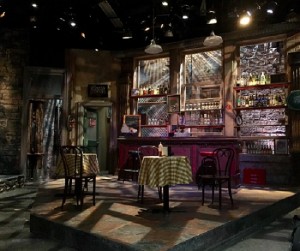
“Our Lady of 121st Street” portrays scared, troubled characters of a Manhattan
community, who come together for the wake of the beloved nun, Sister Rose.
The Queens College Department of Drama, Theatre & Dance debuted their production of Stephen Adly Guirgis’ “Our Lady of 121st Street” on Feb. 18 at The Performance Space, M11, in Rathaus Hall.
Directed by theater professor Claudia Feldstein, the dark comedy, set on 121st Street in Manhattan, focused on the death of nun and community activist Sister Rose and how it affected the people who loved her.
“Almost all of the characters made huge mistakes and struggle to move forward. They are all looking to connect with someone or to be at peace with themselves,” Feldstein said.
The set was divided into three sections. The section on the left showed an open casket in the Ortiz Funeral Room, where Sister Rose’s funeral took place. The middle section was inside a church, focused on a confessional. The right side was a bar.
The absence of God is a major theme of the play, especially when something horrible happens to someone so loved. In this case, it is Sister Rose.
Sister Rose’s body is stolen, and a detective named Balthazar, played by senior and drama major Liam Brennan, tries to find the missing body.
Moreover, failed relationships are a theme in the play too. Not only romantic relationships, but also sibling relationships.
Edwin and Pinky, brothers, struggle with issues with social services. Pinky is mentally disabled, while Edwin struggles to take care of Pinky.
Pinky, played by senior Marlon Moncrieffe, a drama major, felt a special connection with Sister Rose, whom helped him study and avoid special education school.
Moncrieffe stressed he did not want to make a stereotype of mentally disabled people; he just wanted to bring out the human being in Pinky.
Rina Dutta, assistant director and also a senior majoring in drama, said her favorite part of the play involved Inez and Rooftop, who used to be married to each other. Rooftop slept around throughout their relationship, including with Norca, Inez’s friend. This made Inez mad, as her heart turned into a “motherf—ing burnt-out graveyard.”
“It was so raw, natural and beautiful. The cursing in this play was used to express more than just anger, the words brought up the intense emotional pain all of these characters are experiencing,” Dutta said.
Marcia, Sister Rose’s niece, played by junior Eleni Rosenboom, an Art Education major, is a neurotic woman in her 30s. She was closely tied to the nun, but does not see her—and Marcia’s mother—in the same light as everyone else as they were alcoholics.
“[Marcia is] very high strung, but is also looking for someone to save her,” Rosenboom said. “It was hard to make her a well-rounded, real human. So that just took a lot of dissecting the text and letting the text do the job for me.”
Guirgis saw the show, along with three original actors from the New York City production. Leeanna Zayas, who played Norca, is the daughter of David and Liza Zayas, two of the original cast mates. Leeanna Zayas invited all four to attend.
Feldstein felt nervous about Guirgis’ reaction to the play, but she was glad when he enjoyed it as he discovered new things after seeing the play.
“It was cool because he actually told me that Marcia was influenced by his sister, and he said that when he saw me up there, he saw his sister,” Rosenboom said.
Feldstein thought the cast and crew were dedicated and talented, and every character got a chance to reveal what’s in their heart.
“All of these characters with unresolved issues come together and at the fingertips can be healed by each other and by different forces, but the play ends unresolved, the way life would,” Rosenboom said. “A lot of times relationships don’t get fixed and people don’t run off together and have a happy ending. The body is never found, half it is found, and this just leaves that emptiness. It’s a good depiction of life, real life.”














